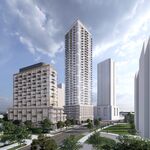denfromoakvillemilton
Senior Member
Member Bio
- Joined
- Apr 30, 2008
- Messages
- 7,453
- Reaction score
- 1,515
- Location
- Downtown Toronto, Ontario
We're getting off topic because you brought up the the YR subways(again) first because Munro (with good reason) is against it. Everyone has concede the subway will have very low ridership past Finch West but somehow VCC is a significant node, more important then the entire east half of the city? I don't think so and this is part of the reason why Scarberians are so mad at the city and the downtown politicians, they are ignored while things like this happen. There is no way you can say the Sheppard Subway is pointless and say the Vaughan extension is worth it. Both go to town centres through low density areas. At the end of the day, the TTC's primary priority is still the resident of Toronto and it's 3 million population. It should not be used as a political tool to gain votes. That's what all the suburban extensions (Sheppard, McCowan, Yonge, VCC) really are.Yawn, this conspiracy stuff is so 2004!
People have been trying to get it up to York for ages as it is (rather obviously) a major node. Simultaneously, the province passed new growth legislation that designated a chunk of land just north of York as a new downtown for Vaughan, something that had also been in the works for like 20 years. Also, the province is only covering 1/3 the cost but believe what you want.
We're getting off-topic but this stuff is just so old. Yes, arguably the Yonge side should have been done first except:
a) There's plenty of people on that thread who think it's just as stupid
b) There are, as we all know major downstream capacity constraints on Yonge
c) Building Spadina first helps alleviate those to a degree
Ergo building Yonge first doesn't make as much sense as it might seem at first glance.
We could take some pride in the fact our under-developed subway is actually going to where there's development but it's better to be like Munro and bitch bitch.
Every transit planning decision (for better or worse; mostly the latter) in this region is political in one way or another. The DRL was political over 50 years ago and if it gets built now, that will be politics too. York Region fought to get the line extended up into their node and paid their fare share AND it's already triggering major intensification which, I thought, was what we wanted suburbs to do. Better it should still be a field and we open more subdivisions in north Vaughan?
I don't doubt Sorbara was involved in the lobbying at some point but this talk of it being "the Sorbara line" or a "subway to nowhere" is just so passe and retrograde. I've said it in other threads but if this was 1970, y'all would be complaining about North York getting a subway up to Finch, where there's naught but farm fields.
The tri-tripartite Vaughan decision (i.e. including 3 governments not involved with Sorbara) was less political and more practical than the Scarborough line - both the Vaughan and Yonge extensions are directly linked to provincial planning policy and major growth centres, for starters - so chew on that.
It's can't always be about "look beyond the borders" and "it's the same city!" and regional nodes!" People, especially the taxpayers in the of Toronto who will pay for all of this, have every right to question it.
Last edited:




